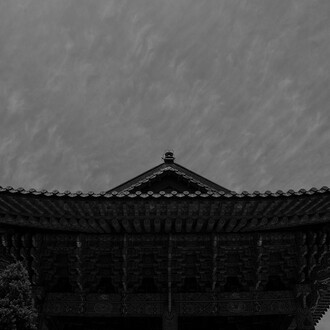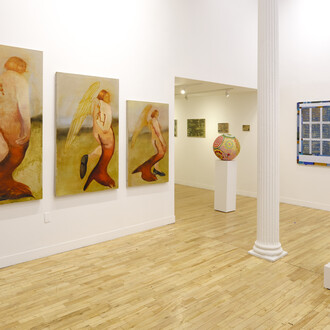Han Kiok is a sixth-generation potter, a ceramicist whose command over clay commands due deference. Even the uninitiated percipient can readily recognize that they are in the presence of a honed artisan of great sagacity. During the Joseon dynasty, Kiok’s ancestor, Youngsuk Han, produced livid, lead-blue works of celadon; as a member of a royal ceramic workshop, he worked in Gwangju during the late Joseon dynasty and initiated what is now a centuries-long inheritance. Consequent generations of family potters include Chisu Han, Sangjun Han, Han Kiok’s father, Changmun Han and Kiok’s daughter Songee Han. Like his forefathers, Han Kiok works with gray-blue livid powder celadon, which is distinct from the green-tinged Goryeo celadon and hoary Joseon porcelain. Kiok’s ceramics, often inscribed with arborescent and floral motifs that mirror the structure of the vessels themselves, are more ashen and silvery; there is an almost naturalist tonality to the works and their dusky palette making them more subdued. This is remarkably apt when one considers the scenography cloaking and wrapping the vessels.
Procumbent trees and supine plant tendrils dance along the spine of a number of these utilitarian wares. Occasionally, bronze-red bushels of flowers sprout are raised in relief, suggesting the breakdown between the natural semblance and the constructed ware. The Korean terrain is implored in full, pocked by traditional motifs like flat-billed cranes perched along a serpentine tree trunk. In one particularly animated exemplar, the etched trunk finds its echo in the stalking shape of the tree-like vessel. This exhibition, like so many of Kate Oh’s ventures into the Korean decorative arts, is unsparing in its commitment to that which lesser galleries and fretful gallerists might deem antiquated or pre-modern. Yet this exhibition solicits the historical without trading on the conceits of the known, departing from the better-known greens of the Goryeo dynasty and the pallid Joseon white that viewers may already be familiar with.
Nevertheless, the history of the Joseon white does command a subtle influence in some of Han Kiok’s work, requiring a brief historical detour. Indeed, no act of artistic departure or gesture of authorial provocation subsists in a vacuum. Due art historical prudence is critical to appreciate the breadth of Han’s art practice. Notably, white wares were produced in limited quantities in the epoch prior to the Joseon period. During the fifteenth century, they were adopted as the imperial ware par excellence (mirroring a precedent that developed in China during the early Ming dynasty, 1368–1644). Transgressing its mere elite status, these hoary whites became the most popular and widely manufactured of Joseon ceramics, with the royal courts of the 1460s supporting kilns called bunwon that were utilized in royal and courtly ceremonies. Bunwon continued to function as official court kilns until they were privatized four centuries later. By the sixteenth century, white wares had become more widespread, no longer solely the dominion of the privileged. Throughout the fifteenth and sixteenth centuries, dishes, bowls, bottles, jars, tableware and burial vessels were so constructed, the minimalism of elite tastes now becoming widespread. The very iron-brown decoration sported in Han’s white wares also rose to prominence during the seventeenth century as ceramists found cobalt too limiting and costly. A coeval thematic uptake included literary narratives and subjects, evinced by bunwon kilns sporting dragons ensnaring rotund jars. Each of these elements and their influences are detectable in Han Kiok’s work.
Han Kiok’s oeuvre threads through many of these thematic shifts. When the viewer understands the colored history of the decorative arts, they are better suited to appreciate the intentionality and homage at play. As we have come to expect from Kate Oh’s prudent, museum-level exhibitions—so often tuned to pockets of the lesser-known amongst Korean decorative art history—this exhibition elicits both erudition and aesthetic reverie.
(Text by Ekin Erkan)
















